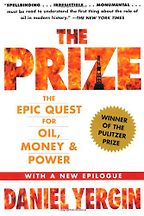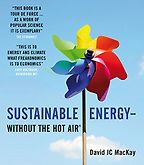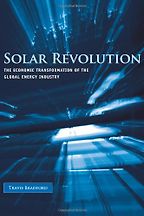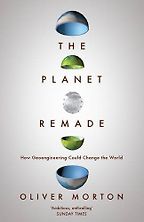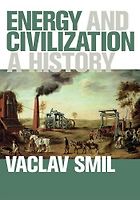Where does your interest in energy transitions—the switch from one fuel to another—come from?
When I started writing about climate change I thought that advanced societies would solve the greenhouse gas emission problem largely by reducing energy consumption by changing habits and improving efficiency. But, as time went on, I came to realise that most people did not want a world in which energy was scarce or its use guilt-generating. They wanted to be able to use it freely and cheaply. Our wish to have a prosperous lifestyle tends to overwhelm our desire to be good climate citizens, even though we know today’s energy consumption has implications for the future of humanity. So, I moved from working on climate change to working on how we make energy cheap but also without deleterious consequences for the global atmosphere.
What is the argument in your book The Switch?
I say that solar photovoltaics will form, for the majority of the world, the bulk of energy supply in fifty years – both electricity and other fuels that have been manufactured using solar energy. That’s an entirely beneficial transition both because solar will be cheap and because it is relatively easy to give people in poorer countries access to electricity that’s from PV — compared to setting up huge power stations and taking networks of electricity cables thousands of kilometres. Although still very much a minority view, I think it is a much less unconventional opinion than it was when I started writing the book in 2015.
“Our wish to have a prosperous lifestyle tends to overwhelm our desire to be good climate citizens”
PV needs to be supplemented by other forms of energy conversion technologies such as wind turbines in less sunny parts of the world, but also with storage. In fact, the majority of the book is about the problems of dealing with the intermittency of solar, both intermittency on a minute by minute basis and more generally because the seasonal availability of sun varies hugely in high latitude locations such as the UK. We have a lot of sun in the summer and virtually none in the winter. But, remember, only ten percent of the world’s population lives north of London. For the vast bulk of the globe, solar is pretty reliable source of energy year round.
Couldn’t a solar revolution happen more quickly than fifty years?
Well, it could, but progress crucially depends on whether the world decides to commit to a single central source of energy such as solar. Most people think that a full-scale transition away from oil, gas and coal will take many decades. One of the books that we’re going to talk is written by Vaclav Smil. He says that energy revolutions — transitions from one fuel to another — take a very very long time and the current switch is going to be no different. Depressingly, he says that optimists, exaggerate the maximum speed of the switch to low-carbon energy sources and that by 2050 renewables will still meet a small fraction of global energy demand.
Smil’s Energy and Civilization: A History (2017) is your first choice. This is an extensively updated and expanded version of a book he wrote in 1994. It covers all of the major transitions in human history. Why do you think this book is useful, particularly if your argument is that actually that he underestimates the likely potential speed of change?
He is extremely scholarly; there isn’t a page you don’t learn something from. In particular, he knows a great deal – probably more than anybody else in the world — about the way that energy was used in past centuries. And he is extremely influential outside academic life. He sets the framework for people’s discussions of our energy future. They may not realise it but when people talk about energy and how we move from one source of energy to another, in the background are things that Smil has written. Everybody talking about energy, in a sense, lies within his orbit because we all accept much of what he says.
“As time went on, I came to realise that most people did not want a world in which energy was scarce or its use guilt-generating. ”
The only point of disagreement is going to be as to whether this transition away from fossil fuels to low-carbon forms of energy can happen faster than he thinks they can. And I personally think there’s good reason to believe that history is not necessarily going to be repeated in this case.
Let’s turn to your second book. This is Daniel Yergin’s The Prize: The Epic Quest for Oil, Money & Power, published back in 1990. Why do you think this book is important to read and to understand in a context of thinking about major transitions in energy?
This book was also reissued recently. The new edition is by no means as extensively rewritten as Vaclav Smil’s book, but it is a wonderfully readable history of the development of the oil age: how the world came from a point where if you had energy it was either biomass—that is wood—or coal, to a point where oil was the dominant source of energy. It was probably never more than fifty percent of total energy worldwide but it has been the most traded energy commodity and it changed the nature of geopolitics over the course of a hundred years from around 1890 to late in the twentieth century. It’s only the rise of shale oil in the US that has reduced crude oil’s central role in world politics.
It’s primarily a book about realpolitik and the politics of oil, isn’t it?
And a lot about the characters of the people who were the developers of oil in the early days. There’s a fascinating chapter in this book about John D. Rockefeller and how he differed from the conventional entrepreneur. We would think of someone like Rockefeller as probably good at running oil rigs and drilling them quickly and selecting the right areas, but what he was was actually an exceptional manager. His success came more from monopolising the means of transport of oil than from the extraction of oil in the first place. That is, the development of the Standard Oil trust in the latter half of the nineteenth century was more to do with monopolising oil transport on the railways than it was about owning a large fraction of total oil production capacity.
But the oil picture has changed, hasn’t it? Now the great majority of the world’s oil is not owned by private corporations but by states, notably Saudi Arabia and Russia and a few others. Bearing in mind the concept of a major transition away from oil, does Yergin take account of a topic beloved of some environmentalists: the idea of a carbon bubble, that is, the idea that we actually now have more oil that we can safely use?
No, not at all. Yergin’s view, I think it’s fair to say, is very similar to Smil’s. His company Cambridge Energy Research Associates (CERA) has published or used some of Smil’s work. These are people who are committed to the view that oil and other fossil fuels are utterly central to modern life and that we really can’t do without them. The recently written epilogue in here is only twelve pages long and not a lot has been changed, I suspect, since the first edition. There’s not much about the future of oil and how the world of energy might be different from the past but I suspect that Yergin sides with Smil in thinking that the transition away from carbon fuels is going to be very slow indeed. I suspect he thinks there is no carbon bubble. I sincerely hope he is wrong.
Can one read the book for warnings for the present moment? Are there lessons, perhaps? Are there, for example, a new generation of renewable energy entrepreneurs who might be the Rockefellers of our day?
No, and I think the reason there is that renewable energies do not lend themselves naturally — or are not thought to lend themselves naturally — to exploitation by big, centralised, multinational behemoths. What we’re seeing is the development, I suspect, of a much more decentralised energy system which isn’t reliant on huge oilfields or enormous coalfields generating many, many terawatt hours of energy. The move is towards both digitalisation — so that things can be controlled centrally but can happen locally — but also there are going to be vastly more places where energy is collected than there are at the moment. These first two books are about the mining of energy and what the world will have to do is to move to the point where we farm energy. That transition has only really just begun, but that’s the nature of the challenge that we face.
Let’s come to your third book, which is a very different. This is Sustainable Energy: Without the Hot Air by David J. C. MacKay. It was published in 2008 and at the time, Bill Gates called it one of the best books on energy ever written. Was he right? If so, why?
Gates takes a very big interest in this whole area. He’s a big fan of Václav as well as MacKay. The fact that Gates continuously refers to Smil as the main thinker in this area is one of the reasons why the world doesn’t believe that transition can happen quickly, because Gates thinks Smil is right and thinks that it will take a long time. In Gates’s words, it will take a miracle to change things.
What the late David MacKay did was give us a rigorous understanding of the way that we use and generate energy. The book is aimed at a British audience but he wanted it to have international relevance and it sold very well abroad. There is a great deal about the basic physics of renewable energy in the book but the majority of the numbers in the book are about British energy consumption and production patterns.
Get the weekly Five Books newsletter
Why this is such a successful book is that it marries both anecdote about how we use energy and a lot of physics to say what the constraints are on us with how that energy is generated, and the mathematics that govern how much we can extract or not extract per unit of time or unit of area. It’s the book that people like me always see when we’re giving talks to groups of people in cold community centres halfway up the country. In the front row there are reliably a few hard-headed engineers with this book sitting on their laps. Their copies of MacKay’s book often have bookmarks showing at the top and have many annotations throughout the text. They quietly wait to challenge anything stupid you say. Although ten years old now, it is extraordinarily influential and it appeals very much to the trained mind because it uses readily comprehensible science to prove its points.
Speaking as a non-physicist and a non-engineer, I found it very clear and brilliantly presented. It’s easy for the non-specialist to understand so long as you’re ready to take a little trouble. One of the things I remember taking away from it is that MacKay is enormously scrupulous about assessing renewable energy potential in the UK specifically. Broadly speaking — and correct me if I’m misrepresenting — his conclusion is that it’s a very big stretch for the UK to achieve a significant proportion of its energy demands from renewables.
I think that is indeed what he wanted us to take away from this. He hoped we would say ‘Crikey, this is going to be very difficult indeed. We really do need to invest in nuclear energy. We don’t have any choice’. But I think that a lot of his assumptions about renewables now look very conservative. Renewables such as wind and solar are far, far more effective sources of energy than he indicated a decade ago.
You have written about this in your blog Carbon Commentary. You say, “since 2008, the fastest developments have been in solar power and in batteries. Perhaps the best way to illustrate just how rapidly solar has moved on is to quote from the figure that David used for the cost of providing each person in the UK with 50 kWh per day. The number was about 91,000 euros for each inhabitant. Today, that’s fallen to about 18,000—or just under 20 percent of the cost of less than a decade ago.” And MacKay didn’t project that kind of fall.
He definitely didn’t project that. He also didn’t project that mainstream commercial solar panels would become as efficient at collecting sunlight as they are today. He told us what the absolute maximum efficiency could be because that’s set by physics, but what he wasn’t able to do was to predict the way in which solar power would come down in price worldwide. He also didn’t want us to put large amounts of solar panels in fields. In a sense, he was an unashamed romantic and wanted the English countryside to stay as it was and thought it would be better to have fifty nuclear power stations dotted around the country rather than perhaps 10 to 15 percent of the country given over to renewable generation of one form or another. I think he was probably wrong but I understand his reluctance to change the landscape.
Do you think the rapid drop in cost of solar—and of course there are other issues that we haven’t yet talked about like storage—undermines MacKay’s case for the inevitability or the need, at least, for nuclear power?
Were he working today, I think MacKay would recognise that nuclear power now looks very expensive compared to renewables plus storage. The other thing that he doesn’t deal with in any way in the book is demand management. That is to say, the whole of the electricity system in the UK and most other parts of the world was set up simply to provide the availability of capacity to produce as much electricity as could ever be needed at the peak half hour, which in this country is on something like a December Thursday at about 5 o’clock in the early evening. We now know that it’s actually rather easy to get people to change their electricity consumption patterns, either by price or by digitalised assets of one form of another. David didn’t talk about that here. He was trying to build a world in which there was availability whenever we wanted it, at a consistent price with no risk of intermittency and no worries about not being able to produce electricity whenever we want it. So, there is also very little in here about storage. There’s a bit about batteries and storage. But it was over ten years ago when he wrote, so that is understandable; he didn’t envisage the huge growth of electric cars and the falling price of batteries that has resulted from that.
Perhaps we can talk about storage a little in relation to the next book which actually appeared two years before David MacKay’s book. This is Travis Bradford’s Solar Revolution. Now, eleven years ago, in the field we’re talking about, is a long time; it’s almost ancient history! Why do you still think this book is relevant?
When I was researching for my book The Switch, I tried to find what people had written about the future of solar energy. And I asked myself, was there anybody out there who had put the evolution of the costs of solar photovoltaics in some sort of robust intellectual framework which allowed him or her to predict the decline in costs that’s actually occurred? And, to my mind, this was the best one out there. But it still comes up with numbers for the costs of solar photovoltaics now or in 2045 which look absurdly high. So, for example, Bradford estimates that a watt capacity of solar photovoltaics by 2045 will cost $1.50. And it’s now fair to say that a good quality Chinese panel now sells in world markets in 2017 at about $0.35. Nevertheless, Bradford understood that the cost of photovoltaics was being driven downwards by the learning curve effect and said it’s inevitable that solar will become by far the cheapest source of electricity, and energy generally, for the bulk of the world.
In The Switch, you present the astonishingly rapid fall in the cost of solar but you also say that it’s not the only part of the equation. To some extent other renewable energy technologies must play a role. And, crucially, even in the brightest scenario — to coin a foolish phrase — the sun only shines some of the time. So, you’ve got to have storage technologies, particularly in northern and extreme southern latitudes I suppose. Even in India, the sun doesn’t shine at night.
The sun doesn’t shine at night. There are monsoons. There are places in China—for example—which are remarkably cloudy. So this by itself does not solve the problem, however cheap solar photovoltaics become. However it does definitely solve part of our problem. For example, in India about twenty percent of current electricity demand is to pull water up from wells and use it for irrigation. And you didn’t have to have that activity going on all the time so, for that type of application and solar is absolutely suitable. Indeed, for a large fraction of the world, the point of highest daily energy demand is in late afternoon when the air conditioning is working at its hardest. For those places, solar is useful; the sun is still above the horizon.
We here in the UK have a different perspective, of course. When we need energy, the sun generally isn’t shining. For the bulk of the world, solar is pretty good. But, everywhere is going to need storage. It’ll either be storage in the form of things like concentrating solar power, which is where the sun heats a liquid or fluid of some form during the day and that heat — we’re talking about hundreds of degrees centigrade here — is used at night to create steam to drive a turbine. That is being taken up in various parts of the world, such as Morocco, South Africa, China, Saudi Arabia, and Dubai. That’s a way of capturing the sun’s energy during the day and using it at night.
“Renewable energies do not lend themselves naturally — or are not thought to lend themselves naturally — to exploitation by big centralised multinational behemoths.”
But the most important thing is batteries for short-term overnight storage. There, we have seen exactly the same phenomenon as we have seen with PV, with costs coming down in a way that nobody predicted, driven by the iron law of the learning curve. The mathematics behind the learning curve gives you a figure for the amount that the cost of something will fall that is derived from how much of it is produced. So, a learning or experience curve typically says that once the production of a commodity such as PV panels has cumulatively doubled, the cost will fall by a predictable amount.
In the case of PV, in Travis Bradford’s book he suggests that every time the accumulated volume of solar photovoltaics panels that has ever been produced has doubled the cost has fallen by about 18 percent. Today this number is thought to be nearer 20 percent but he got the number basically right over ten years ago. That means, if solar panel production is growing at 40 percent a year—which is what solar has done for the last fifty years—very roughly the cost will go down by 20 percent every two years—indefinitely—in a relatively smooth decline. And that’s happened with batteries as well.
There are lots of other different forms of storage. One that’s attracting a lot of attention at the moment is storage in compressed air. There are some technical problems with that but it looks as though it’s going to be fairly widely used. You pump air when electricity is available from the sun at high pressure into a salt cavern or something like that beneath the surface and it comes out, when you need the electricity, and drives a turbine. So, batteries and other short-term storage mechanisms are there and available to us. But long-term storage is more of a problem and that’s what the last chapters of my book deal with.
Your final book is rather different again. This is The Planet Remade by Oliver Morton, published in 2015. This is a book largely about geoengineering. How is this relevant to the great energy transitions?
By ‘geoengineering’ we mean alteration of the world’s physical systems in a way that changes the planet’s ecological balance. Most of Oliver Morton’s book is about reducing the amount of the sun’s energy that gets through to the earth’s surface as a way of counterbalancing the increase of the heat blanket in the earth’s atmosphere.
However, he also points out that the the invention of the Haber-Bosch process in the first decades of the twentieth century enabled the world to convert fossil fuels into nitrogen-based agricultural fertiliser and he calls this geoengineering as well. The application of artificial fertiliser to fields expanded the total amount of energy from food that’s available to the planet’s inhabitants. In turn, that loosened the Malthusian constraints on the world’s population. Smil has shown that before the use of fossil fuels for such things as fertiliser energy availability per person was only a few kilowatt hours a day.
The increase in human wellbeing coming from greater fertiliser availability has had a growing impact on the concentration of CO2 in the atmosphere. It was, as George Monbiot has so beautifully written, a Faustian bargain that gave us prosperity today in return for a possible climate hell in the future. If Václav Smil and Daniel Yergin are right, we are deluding ourselves if we think we can switch to low carbon energy sources fast enough to avoid that hell. Inevitably, Oliver says, we do need to contemplate solar radiation management, that is to say using some form of chemical to block the sun’s radiation so that it doesn’t reach the earth’s surface.
This is the idea of putting dust up into the stratosphere?
Yes. Oliver says that we have a big problem. We know that we want to continue to be able to use large amounts of energy, we know that it’s going to be difficult to switch to entirely non-fossil fuel sources and give people cheap reliable energy, therefore, as sensible human beings, we need to think about what happens if we cannot pull down our fossil fuel use fast enough. And what the book is really about is a plea for people to start thinking about this, rather than saying— as they tend to do at the moment—that we shouldn’t talk about geoengineering because it makes us think we have an excuse for not doing anything about carbon emissions because we can always get rid of the problem by throwing up a few thousand tonnes of sulphates into the upper atmosphere.
I’ve heard the distinguished climate scientist Ken Caldeira say that, sure, we should we looking at geoengineering and yes there may be some technical fixes but when you look at the costs, it’s almost always likely to be much cheaper to just reduce carbon emissions in the first place than to geoengineer.
Well, what Oliver tries to do in this book is to show that that’s not necessarily the case; that it’s really quite cheap. The contention is that solar radiation management — putting a blanket outside the stratosphere — is relatively inexpensive compared to, say, the cost of building nuclear power stations across the world to reduce the use of fossil fuels. But there are enormous ethical issues. It’s not just a question of putting a rocket up there and blasting the sulphates out.
Do you find the argument plausible?
I think the world needs to look at it. I think Oliver is right to ask us not to just dismiss it. There are lots of problems with geoengineering using sulphate aerosols, including that it will probably change the world’s rainfall patterns. Areas which have a lot of rainfall at the moment might have much less in the future. Others might have too much. Getting the global community to act when one large group of people suffer and another large group of people benefit has proved to be almost impossible in the past and may well be so in the case of geoengineering. But I think Oliver Morton is right to insist that because climate change could be utterly devastating — and fairly soon — for large parts of the world we need at least to openly discuss how the global community might reach a decision to geoengineer the atmosphere. And, like the other books in this selection, it is an engaging and informative read from a fine stylist.
“As sensible human beings, we need to think about what happens if we cannot pull down our fossil fuel use fast enough. ”
I wanted to conclude by breaking the rules and talking briefly about a sixth text. This is not a book but a recent academic article. I’ve included it both because it is an absolutely superb piece of writing and also because it was written by a woman. All the rest of the works in this list are by men. That troubled me. Climate change already disproportionately affects women. In many places, for example, they have to travel further for water and for wood as a result of temperature and rainfall change. However the world of energy production and energy research, as well writing about energy, is wholly dominated by men. This has to change.
So let me talk Olivia Judson’s fine paper for a moment. In The Energy Expansions of Evolution, which was published earlier this year and is available outside a paywall, Judson shows how from the earliest times organisms have exploited the energy available to them. Evolution, as in the development of cyanobacteria, allowed the use of different sources of energy. What Olivia shows, as with all the works in my micro-library, is that energy availability is central to the development of living things, including the human race. Energy availability has been, and will continue to be, the central determinant of human prosperity. The challenge is to find ways of farming it, and then storing it, rather than mining it from the crust. Since the sun provides at least six thousand times as much direct energy as we are ever likely to need — two orders of magnitude more than any other source — solar energy is now the obvious choice.
Five Books aims to keep its book recommendations and interviews up to date. If you are the interviewee and would like to update your choice of books (or even just what you say about them) please email us at [email protected]
Five Books interviews are expensive to produce. If you've enjoyed this interview, please support us by donating a small amount.



